Celestial Siblings: Norse Sun and Moon Gods Chased Across the Sky
Chased across the sky by a pair of wolves, the Norse sun and moon gods were tasked with a heavy burden. The Sol and Mani were responsible for pulling a chariot across the sky every day and night while simultaneously evading a gruesome death at the hands of wolves. The task was split between the two; Sol operated during the day, and Mani during the night.
Similar tales have been told throughout history by many civilizations, and because of this, the tale of the Norse sun and moon gods Sol and Mani remains influential in numerous cultures. Many ancient mythologies attribute the creation of the sun and the moon to a pair of siblings, one male and one female, who traveled across the sky in some type of vehicle. But where did this originate? How did the Norse people believe their sun and moon were created, and by whom?
Norse Sun and Moon Gods Sol and Mani in the Gylfaginning
The written sources on the Norse sun and moon gods Sol and Mani are somewhat incomplete. The one that offers us the best picture is perhaps the Prose Edda, written by the 12th-century Icelandic scholar Snorri Sturluson.
Although the Prose Edda is one of the most complete Norse texts, historians believe that Sturluson may have taken some creative liberties. This is because actual written Norse sources from that time were extremely limited and rare. Sturluson, therefore, had a lot of gaps to fill.
- The Bodiless God of Wisdom: Mimir in Norse Mythology
- Jotunheim: Outsized Tales from the Norse Land of the Giants
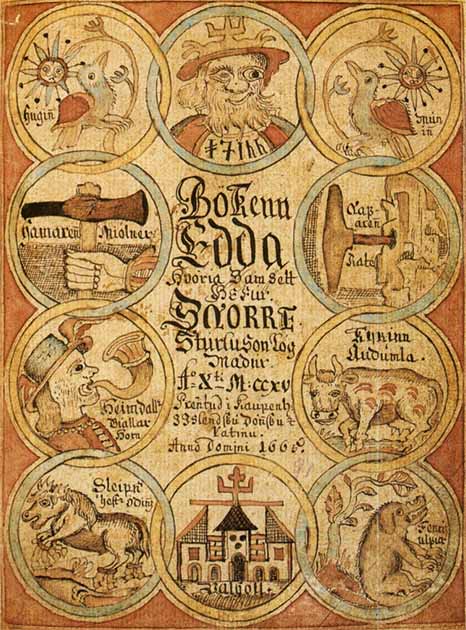
Title page from an 18th century manuscript of the Prose Edda, one of the most complete compilations of Norse myths. The Norse sun and moon gods, Sol and Mani, appear in the first section, called the Gylfaginning (Public Domain)
The first part of the Prose Edda is called Gylfaginning, and contains the story of a legendary Swedish king called Gylfi. In this tale, Gylfi embarked on a quest to uncover knowledge about the world. Among other revelations, he learned the story of the sun and the moon from the Norse gods.
According to Sturluson, Gylfi was told that a man from Midgard named Mundilfari (thought to translate as ‘The One Who Moves According to Particular Times’) once had two children. Mundilfari believed his children were breathtakingly beautiful, and in order to reflect this, he named them after the sun and the moon. Mundilfari married his daughter, Sol, to a man named Glenr (‘Opening in the Clouds’).
The Norse gods took offence to Mundilfari’s vanity and:
“took the siblings and put them in heavens, let the Sun drive those horses dragging the chariot of the sun which the gods made to lighten the world from the glowing stuff coming out of Muspellheim" (Faulkes 2005)
Muspellheim was the realm of fire where the fire giants resided. From there, the sun was formed from sparks. The pair were provided with horses named Árvakr and Alsviðr, meaning "early-awake" and "very quick", who were entrusted to pull a chariot across the sky each day and night.
The story of Mundilfari and his two children was also recorded in the poem Vafþrúðnismál ("Ballad of Vafthrudnir"). According to the legend, Odin competed with a giant in order to determine who had more mythical knowledge. The poem stated:
“He is called Mundilfari,
Father to the Moon
Also father to the Sun;
They will float
On the sky every day,
So we can tell time.”
(stanza 23)
Sol was given the task of pulling the chariot across the sky during the day, and Mani during the night. It was not a peaceful journey for either of the siblings. Sol was chased across the sky by a wolf named Hati (“Hate”), and Mani was chased by Hati ’s sister Skoll ( “Mockery”). Some sources stated that the wolves were the children of Fenrir, the monstrous son of Loki.
“There are two wolves, and Skoll is the name of the one chasing her. She fears him, and he will get her; the one leaping in front of her is called Hati, son of Hrodvitnir [possibly Fenrir] , and he will get the moon, so it must be.” (Faulkes, 2005)
- Nidhogg, the Chaos Bringing Dragon of Ancient Norse Mythology
- Kvasir and the Mead of Poetry in Norse Mythology
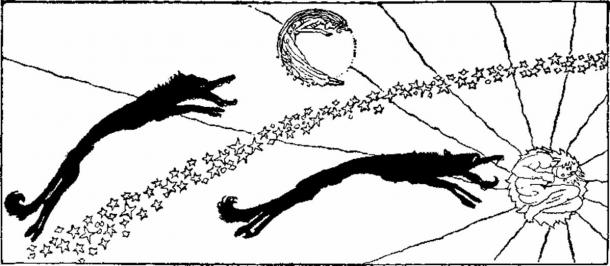
The Norse sun and moon gods Sol and Mani, being chased across the sky by wolves Sköll and Hati, by Willy Pogany, 1920. (Public Domain)
The pair managed to outrace the wolves every day and night until Ragnarök (the end of the world according to Norse mythology), when they were eventually captured and devoured. Upon their demise, the world was plunged into darkness. Some sources stated that the wolves then left the sky and traveled to Midgard, where they ate the dead bodies that had been thrown across the land.
Sturluson went on to emphasize, however, that light was not lost forever. Fortunately, before she was captured by the wolves, Sol had given birth to an equally beautiful daughter. This daughter managed to survive the battle of Ragnarök.
The gods who had survived Ragnarök returned to Asgard, and proceeded to build a new land where humans could thrive. The human race began again when a human couple appeared out of the branches of Yggdrasil. After this, Sol’s daughter was given her mother’s place in the sky and entrusted to light up the new world.
Other Sources
Without Sturluson’s work, it is hard to piece together the myth. The only other written sources exist in fragments with many gaps. However, they still reveal interesting insight into what Norse people would have believed.
There are some differences between these sources and Sturluson’s work. Some claim that, rather than coming from a human father, Sol and Mani were created with the sole purpose of giving light to the world and to mark the passage of time. They state that the cosmos emerged from nothingness. In the poem Völuspá a prophetess revealed information about both the start and end of the world:
“The sun, sister of the moon,
Shone from the south,
With her hand
Over the rim of heaven;
The sun did not know yet
Where her home should be,
The moon did not know yet
What power he had…”
(stanza 5)
The gods eventually met and organized the different parts of the day and year, as well as the phases of the moon. With this, Sol and Mani were told by Odin where they fit into the cycle of time in the universe. Odin then guided them across the sky and showed them the correct path to take on their journey.
In the Poetic Edda, it was said that a man named Svalinn accompanied Sol in her chariot and held a shield between her and the earth. He did this to prevent the earth below from being consumed by flames. Similarly, in some sources, Mani was given helpers in the form of children named Bil and Hjúki, who held up a cask and pole visible from Earth.
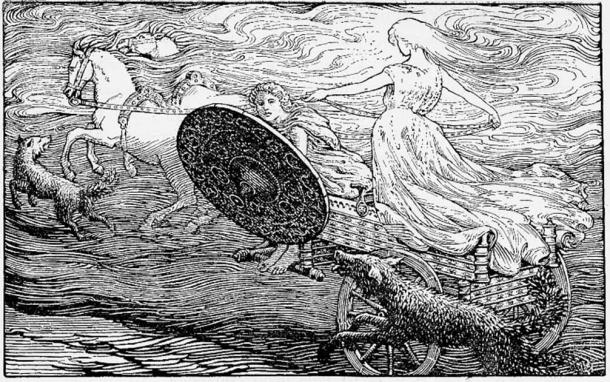
The chariot of the Norse sun god Sol, protected by Svalinn, chased by the wolf Hati (Public Domain)
We know the basic narrative that runs throughout these sources must be extremely old. The tale has been found carved into rocks and on other Scandinavian artifacts that originated in the Bronze Age. An example of this is the Trundholm sun chariot. Because of the limited number of written sources remaining, these physical sources of the story can be extremely telling.
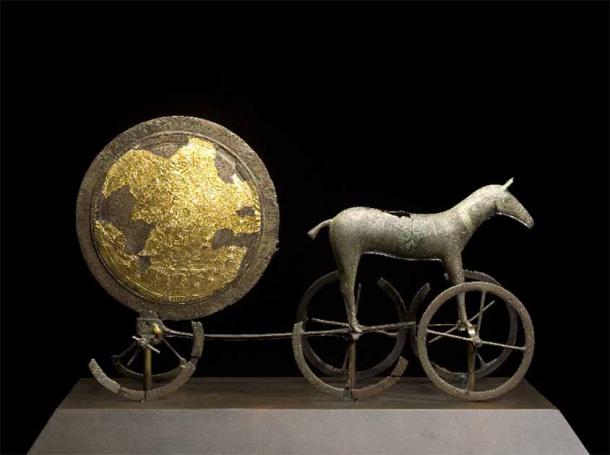
The Trundholm sun chariot, a Bronze Age artifact depicting the sun pulled by a horse, discovered in Denmark in 1902 (NationalMuseet / CC BY SA 3.0)
There are other, smaller differences between some of the written sources. For example, in Vafþrúðnismál, rather than being devoured by Hati, as Snorri stated she was, Sol was devoured by the father of the wolf, Fenrir:
“The elf-disc
Bears a daughter
As soon as Fenrir eats her;
When the gods have died
She treads her mother's path.”
(stanza 46-47)
Furthermore, The Ballad of Vafthrudnir gave the horses responsible for pulling the chariots different names. There they were called Skinfaxi (shining mane) and Hrimfaxi (frost mane). The former operated through the day and the latter during the night.
Similarities of Norse Sun and Moon Gods to Other Cultures’ Myths
There are many parallels between the story of the Norse sun and moon gods, Sol and Mani, and other myths across the globe. Most ancient civilizations had a pair of deities to represent or personify the sun and the moon. Their story is so similar to other European myths about the sun and the moon that Sol and Mani’s story is often confused with later stories from other cultures that were actually inspired by them.
There has been some confusion between Norse and Roman myths because the Latin word for sun is ‘sol’, so the Roman sun god was also named Sol. However, many argue that the similarities are linguistic only, rather than substantive similarities. For those outside of Scandinavian culture, Sol’s name was changed to incorporate the local language. For example, in Germany, the sun god was named Sunna (the root of the English word ‘sun’).
Another similarity is that many ancient cultures depicted their sun and moon deities as siblings, and often of differing genders. For example, in Greek mythology, there are the tales of Apollo and Artemis, as well as Helios and Selene.
Additionally, many sun and moon god myths incorporate the use of a chariot or other vehicle to travel across the sky. For example, in ancient Egypt, the sun god Ra was commonly depicted on a boat. Similarly, in Greek mythology, Helios and Selene drove chariots, like Sol and Mani did.
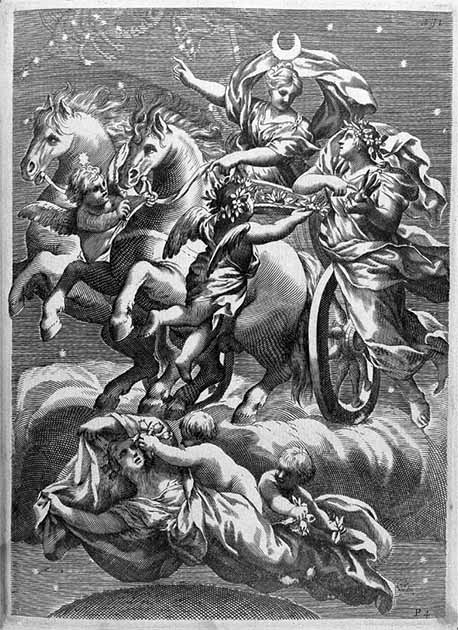
Depiction of Selene, Greek goddess of the moon, in a flying chariot drawn by two white horses. The Greek sun and moon gods Selene and Helios, parallel the Norse sun and moon gods, Sol and Mani. (Wellcome Collection / Public Domain)
The main difference between the Norse myth and other Indo-European myths is that the sun is usually masculine and the moon feminine. In this sense, the Norse myth was the reverse of the norm. This is most likely because the genders correspond with their respective languages. In Latin, the word for Sol is a masculine noun, while in Norse, the noun Sol is feminine.
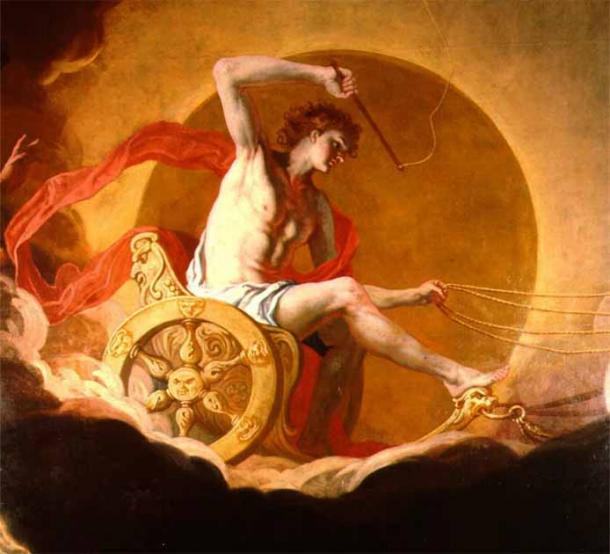
The Greek sun god Helios drove a chariot, like the Norse sun god Sol; however, the genders of the siblings are switched. Painting by Hans Adam Weissenkirchner, 1685 (Public Domain)
Conclusion
In conclusion, the story of Sol and Mani is an interesting one. It is difficult to tell what is part of the original Norse myth and what was added at a later date. However, because of the similarities between other ancient myths from other cultures, it is evident that at least at its most basic level, the story was influential.
Historians are helped further by the physical evidence remaining from Norse people, such as rock carvings and decorative objects. Their cultural artifacts have enabled us to piece together the story today and gain further insight into Norse creation mythology.
Top Image: The Wolves Pursuing Norse sun and moon gods Sol and Mani Source: John Charles Dollman, 1909, Public Domain, colorized
By Molly Dowdeswell
References
Faulkes, A. 2005. Edda: Prologue and Gylfaginning. University College London.
Greenberg, M. November 30, 2020. Who Were Sol and Mani in Norse Mythology? Mythology Source. Available at: https://mythologysource.com/sol-mani-norse-gods/
Manea, I. January 5, 2022. The Sun & The Moon in Norse Myth. World History Encyclopedia. Available at: https://www.worldhistory.org/article/1911/the-sun--the-moon-in-norse-myth/
McCoy, D. Sol and Mani. Norse Mythology for Smart People. Available at: https://norse-mythology.org/sol-mani/




















Comments
It’s when the dismal truth of history is replaced by a children’s coloring book.
You just wonder what really happened, surviving the Ice Age way up there, the untold EPIC story of the great fair-haired people – against all odds.
Nobody gets paid to tell the truth.